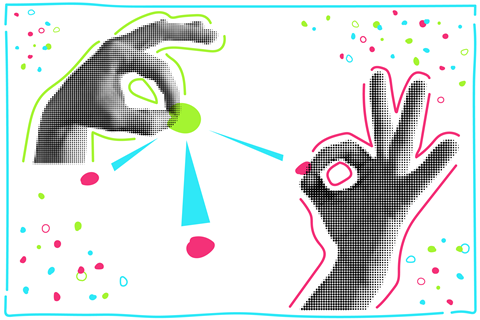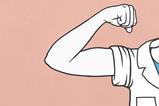Get your students to use hand gestures to boost their understanding of difficult chemistry concepts
Visuospatial thinking is widely considered to be a fundamental cognitive component of problem solving in science learning. Spatial ability involves being able to mentally generate, rotate and transform imagined images. Such mental visualisation and imagistic reasoning play a key role in learning about science at advanced levels.

Research has shown that problem solvers employ imagistic reasoning, along with other strategies like analytical reasoning. Gesture is a vital representational mode. Hand gestures, in particular, help to convey relational, spatial and embodied concepts.
Studies have shown that novice students often access imagistic strategies to visualise molecular structures when translating between 2D and 3D representations. Post-16 students typically first encounter this challenge when they learn Valence shell electron pair repulsion (VSEPR) theory. VSEPR provides an algorithmic method used to predict the 3D shape of many molecules.
Teaching tips
- Identify ineffective hand gestures students use which could potentially create misconceptions. Video students to capture gestures for group analysis and feedback.
- Understand how your hand gestures can support the communication of complex concepts. These can be a useful cue for students when answering questions and solving problems.
- Create a rubric that focuses on speech and gestures to help students develop a method or algorithmic approach for tasks they undertake.
Visuospatial thinking
A study explored the role of visuospatial thinking in helping students master molecular geometry. The researchers designed an open-ended written activity to capture individual aspects of student reasoning, and 16 students participated. They had to describe their understanding of the 3D shape of molecules during an 80-minute double period.
The teacher delivered an initial 20-minute lecture on VSEPR in PowerPoint, followed by an eight-question written exercise. Students worked in pairs, filming one another in predicting the molecular geometries of selected compounds. They had 30 minutes to complete the task and were familiar with the video-recording approach. All 3D molecular models were removed from their view during this process.
Students used more imagistic reasoning when considering molecules with fewer than five atoms and those with lone pairs
The researchers analysed the video data to identify instances of gesturing, with a total of 440 gestures characterised across the cohort. Here’s an example of how the data was interpreted: ’Imagine that the central atom is here (left fist clenched to represent the central atom), then the hydrogens go here (pointing with right hand to space around fist), here (pointing to different space around fist) and here (pointing to third location around fist).’
Interestingly, students used more imagistic reasoning when considering molecules with fewer than five atoms and those with lone pairs.
The researchers identified five different gesture types.
- Beat: repeatedly raising both hands up and down while stating ‘because the lone pairs repulse more’
- Deitic-beat: repeatedly pointing with hands to emphasise the delivery of speech rather than to convey imagistic information
- Deitic: pointing at four imaginary points in space while stating: ‘you’ve got an N at the top and three Hs here, here and here’
- Deitic-iconic: two-handed gestures where one hand depicts an iconic representation such as a trigonal pyramidal shape, with the other hand pointing to locations on the first hand to indicate atom positions
- Iconic: one- or two-handed gesture representing a molecular shape
Overall, the findings matched previous studies which found that novice learners tend to rely on imagistic reasoning strategies when first learning a topic, before discovering alternative analytical strategies. Experts would have long since mastered analytical approaches to scaffold their problem solving. In this study, students had this scaffolding from the start, yet many still appeared to persist with imagistic strategies.
More like this
- Add these gestures to your arsenal of teaching techniques to boost behaviour management in your classroom.
- Use hand gestures to improve students’ retrieval and problem solving skills.
Reference
N Kiernan et al, Chem. Ed. Res. Pract., 2024, 25, 524–543 (doi.org/10.1039/d3rp00186e)
David Read
References
N Kiernan et al, Chem. Ed. Res. Pract., 2024, 25, 524–543 (doi.org/10.1039/d3rp00186e)











1 Reader's comment